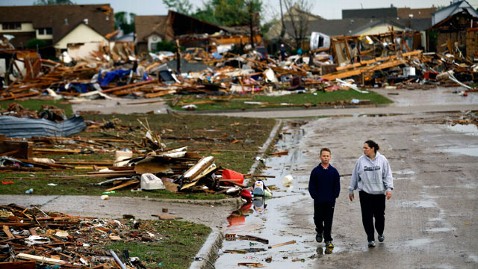Oklahoma Tornado: How Experts Classify Twisters

(Image Credit: Joshua Lott/AFP/Getty Images)
One of the most devastating tornadoes in the nation's history tore through the Oklahoma City metropolitan area Monday, killing at least 24 people and leveling entire communities.
Among the dead were nine children. Numerous homes and vehicles were damaged during the tornado.
RELATED: Oklahoma Tornado - How to Help
The storm has been categorized as an EF-5, the most powerful tornado as measured by the Fujita Tornado Intensity Scale.
Introduced in 1971 by University of Chicago professor T. Theodore Fujita in collaboration with Allen Pearson, the scale ranks a tornado's power based on its estimated wind strength and the damage it has caused.
In 2007, the National Weather Service began using the Enhanced Fujita (EF) scale. Measuring tornadoes from EF-1 to EF-5, the scale uses more specific structural damage guidelines than the original Fujita scale.
Here is a listing of the categories, along with the potential for damage:
EF Scale for Categorizing Tornados
EF-0 (Winds of 65 to 85 mph)
Light damage. A tornado of this strength might break branches off trees, uproot shallow-rooted trees, damage sign boards and damage chimneys.
PHOTOS: Oklahoma Tornado Levels Towns
EF-1 (86 to 110 mph)
Moderate damage. An EF-1 tornado might push mobile homes off their foundations, push cars and peel roofing.
EF-2 (111 to 135 mph)
Considerable damage. This kind of tornado might destroy mobile homes, snap or uproot large trees, lift cars off the ground, tear roofs of frame houses and send light objects through the air.
EF-3 (136 to 165 mph)
Severe damage. This storm might tear the walls of well-constructed homes, lift and throw cars, overturn trains and uproot numerous trees.
EF-4 (166 to 200 mph)
Devastating damage. This storm might level well-built homes, send structures with weak foundations flying, send cars and other large objects flying through the air.
EF-5 (200 mph and higher)
Incredible damage . Strong frame houses will be ripped from foundations and carried away, cars and other large objects will be sent flying far distances, bark will be ripped from trees.
Source: U.S. National Oceanographic and Atmospheric Administration's Storm Prediction Center.